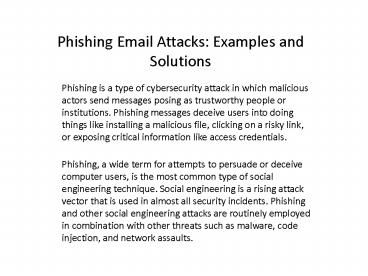Phishing Email Attacks: Examples and Solutions PowerPoint PPT Presentation
Title: Phishing Email Attacks: Examples and Solutions
1
Phishing Email Attacks Examples and Solutions
- Phishing is a type of cybersecurity attack in
which malicious actors send messages posing as
trustworthy people or institutions. Phishing
messages deceive users into doing things like
installing a malicious file, clicking on a risky
link, or exposing critical information like
access credentials. - Phishing, a wide term for attempts to persuade
or deceive computer users, is the most common
type of social engineering technique. Social
engineering is a rising attack vector that is
used in almost all security incidents. Phishing
and other social engineering attacks are
routinely employed in combination with other
threats such as malware, code injection, and
network assaults.
2
Types of Phishing
- Email Phishing
- Spear Phishing
- Whaling
- Smishing and Vishing
- Angler Phishing
3
Email Phishing
- The majority of phishing assaults are delivered
via email. Attackers generally establish bogus
domain names that resemble legitimate businesses
and send hundreds of repetitive requests to
victims. - Attackers may add or substitute characters
(my-bank.com instead of mybank.com), utilize
subdomains (ank.host.com), or use the trusted
organization's name as the email username
(mybank_at_host.com) to create phony domains. Many
phishing emails induce a feeling of urgency or
threat to persuade the recipient to act fast
without first verifying the source or legitimacy
of the email.
4
Spear Phishing
- Malicious emails addressed to specific people are
examples of spear phishing. Typically, the
attacker already possesses some or all of the
following information on the victim - Name
- Place of employment
- Job title
- Email address
- Specific information about their job role
- Trusted colleagues, family members, or other
contacts, and samples of their writing - This information aids in the success of phishing
emails and the manipulation of victims into
undertaking tasks and activities such as money
transfers.
5
Whaling
- Whaling assaults target top management and other
positions of power in an organization. The
ultimate purpose of whaling is the same as other
forms of phishing attempts, although the approach
is frequently quite subtle. Senior workers
usually have a wealth of knowledge in the public
domain, which attackers might utilize to design
very powerful assaults. - Typically, these assaults do not employ
techniques such as malicious URLs and bogus
links. Instead, they employ highly tailored
communications based on information gleaned from
a thorough study of the victim. Whaling
attackers, for example, utilize fraudulent tax
returns to get sensitive information about the
victim and use it to design their assault.
6
Smishing and Vishing
- This is a phishing attempt that involves a phone
call or a text message. Smishing is the
fraudulent transmission of SMS messages, whereas
vishing is the fraudulent transmission of phone
calls. - An attacker in a common voice phishing scam
poses as a fraud investigator for a credit card
firm or bank, notifying victims that their
account has been compromised. Criminals then
request payment card information from the victim,
ostensibly to verify their identification or
transfer funds to a safe account (which is
actually the attacker's). - Vishing schemes may also use automated phone
calls posing to be from a trustworthy source and
instructing the victim to input personal
information onto their phone keypad.
7
Angler Phishing
- These assaults take advantage of bogus social
media profiles associated with well-known
organizations. The attacker uses an account
handle that looks like a legitimate firm (for
example, _at_pizzahutcustomercare) and the same
profile image as the real company account. - Attackers take advantage of consumers'
proclivity to use social media platforms to lodge
grievances and solicit assistance from companies.
Instead of contacting the legitimate brand, the
customer contacts the attacker's bogus social
account. - When attackers get such a request, they may seek
personal information from the consumer in order
to identify the problem and respond correctly. In
other circumstances, the attacker sends a link to
a bogus customer service page that leads to a
malicious website.
8
Methods to Prevent Phishing
- It is critical to teach your staff to recognize
phishing methods, detect phishing signals, and
report suspicious instances to the security team.
Similarly, before dealing with a website, firms
should urge employees to check for trust badges
or stickers from well-known cybersecurity
solutions or antivirus providers. This
demonstrates that the website is concerned about
security and is not likely to be fraudulent or
harmful. - Modern email filtering technologies can protect
email communications from viruses and other
dangerous payloads. Emails with harmful links,
attachments, spam material, or language that
might indicate a phishing assault can be detected
by specific cybersecurity solutions. Email
security solutions automatically detect and
quarantine questionable emails, and they employ
sandboxing technology to detonate emails to
determine whether they contain harmful code. - The increased usage of cloud services and
personal devices in the workplace has resulted in
a plethora of new endpoints that may or may not
be completely secured. Endpoint assaults will
compromise certain endpoints, thus security teams
must prepare for this possibility. Monitoring
endpoints for security risks and implementing
timely cleanup and response on compromised
devices are critical. - Get DMARC, SPF, and DKIM from EmailAuth and
secure your email systems today. EmailAuth has a
full list of email authentication services lined
for your domain including DMARC, SPF, DKIM, etc.
The benefits of DMARC are unparalleled and
provide unhinged support to your domain for the
safety and deliverability of the emails. Create
your DMARC record today using EmailAuths free
DMARC record generator.

